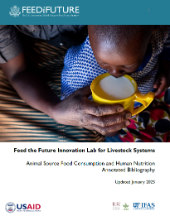Human Health, Food Safety, Diets & Nutrition
The goal of improving human health and nutrition through research in the livestock system inspires us to conduct research that can impact the lives of people living in low- and middle-income countries. Human growth and development are complex, multifactorial processes, and no single intervention can adequately address all underlying causes of impairment. We distinguish two areas of research related to animal-source foods (ASF).
1. Safe livestock production and food safety
Previous research addressed pathogens and toxic substances in human food and livestock feed, the costs of foodborne disease, risk assessments, and risk prevention and mitigation. Impaired childhood growth and development can be due to increased exposure to diarrhea-causing pathogens that originate from livestock reservoirs which are increasingly recognized as causative agents of Environmental Enteric Dysfunction (EED). Phase II research will seek to improve the safety of ASF from production to consumption. We emphasize a One Health approach to Water Sanitation and Hygiene (WaSH) that includes reducing exposure to livestock-borne pathogens. We pursue the following research areas:
- Human-livestock interactions: Research to better understand and mitigate the risks of human-livestock cohabitation in smallholder households. This will include: 1) source attribution studies to better understand and quantify the contribution of different livestock species to exposure of children to enteric pathogens; 2) comparative exposure and risk assessment studies; 3) intervention trials of cost-effective and sustainable methods of separating children from livestock and their excreta, and 4) studies on how collection and use of livestock manure as a resource in smallholder settings contributes to reducing exposure of children to pathogens.
- Food safety: Research to assess the risks and propose and test culturally appropriate interventions to improve the microbial safety of ASF that are consumed raw or with inadequate processing for safety, as well as ready-to-eat ASF. Pathogens of concern are primarily bacteria and protozoa with putative animal reservoirs, but we will also examine pathogens with exclusively human reservoirs because ASF contamination can occur during intensive handling throughout the value chain.
- Risk assessment: Building on Phase I results, we will seek to integrate existing data into risk assessments that may support deriving appropriate standards for safe levels of aflatoxins in animal feeds, milk, and other dairy products. Application of US or European standards may be inappropriate for target countries; yet, these are used given the absence of country specific standards. Our approach will allow countries to come up with more relevant and feasible standards while taking a perspective that balances the risks for animal and human health with the nutritional benefits of these products, particularly for vulnerable groups.
2. Consumption, dietary diversity and adequacy
Diverse and healthy diets, which include nutrient-dense foods, particularly ASF, are often rare in vulnerable populations. Low consumption of ASF/nutrient-dense foods can lead to sub-optimal nutrition and health outcomes. Increasing consumption of ASF is more complicated than increasing production of ASF, as it may be additionally constrained by cost, value of ASF, markets, and cultural norms and behavior. Phase II research will pursue the following areas:
- ASF production impact: Research to understand the impact of increased livestock production or productivity on nutritional outcomes. This research will build on existing evidence and address knowledge gaps identified in existing studies to better translate livestock production and productivity gains to ASF consumption and improved diets.
- Barriers to ASF consumption: Research to identify and overcome cultural, economic, and structural barriers to ASF consumption by vulnerable populations. These may include household-level interventions, community based social-marketing, market-based research, or policy-level intervention and/or analysis. We will encourage studies that examine strategies (e.g. financing) to increase ASF affordability and accessibility and their effects on ASF consumption. In addition, we will support approaches to overcoming other barriers that provide evidence from multiple countries or have strong potential to scale. Rather than funding research that explicitly tests the effect of ASF consumption on determinants of stunting and child development outcomes, we will encourage inclusion of nutritional and child development indicators like minimum acceptable diet, minimum dietary diversity, minimum meal frequency, head circumference, and others in studies that seek to improve ASF consumption and quality of diets.
- Behavioral change for ASF consumption: Research to increase the current knowledge base on specific behavior change strategies to increase ASF consumption. This will include improved understanding of the relationship between nutritional and livestock-related knowledge, attitudes, and practices, and ASF consumption. We will seek to understand the contexts in which behavior change strategies increase ASF consumption (e.g. proximity to markets, conducive current cultural practices and norms; income/poverty thresholds.
Journal Articles
Adesogan, A., McKune, S., Eilitta, M., Havelaar, A., and Dahl, G. 2019. Animal source foods: sustainability problem or sustainability and malnutrition solution? Perspective matters. Global Food Security. https://doi.org/10.1016/j.gfs.2019.100325
Balehegn, M., Mekuriaw, Z., Miller, L., McKune, S., and Adesogan. A. T. 2019. Animal source foods for improved cognitive development. Animal Frontiers. https://doi.org/10.1093/af/vfz039
Givens, D.I. 2020. MILK Symposium review: The importance of milk and dairy foods in the diets of infants, adolescents, pregnant women, adults, and the elderly. Journal of Dairy Science, Volume 103, Issue 11. https://doi.org/10.3168/jds.2020-18296
Magalhães, M., Ojeda, A., Mechlowitz, K., Brittain, K., Daniel, J., Roba, K.T., Hassen, J.Y., Manary, M.J., Gebreyes, W.A., Havelaar, A.H. and McKune, S.L. 2022. Socioecological predictors of breastfeeding practices in rural eastern Ethiopia. International Breastfeeding Journal, 17, 93. https://doi.org/10.1186/s13006-022-00531-3
McKune, S., Lane, J., Flax, V., Ouma, E., Austin-Datta, R., Williams, R., Moore, E., Jacobs, M. and Turk, J. 2020. Making livestock research and programming more nutrition sensitive. Global Food Security, Volume 26, 100430. https://doi.org/10.1016/j.gfs.2020.100430
McKune, S.L., Mechlowitz, K., and Miller, L.C. 2022. Dietary animal source food across the lifespan in LMIC. Global Food Security, Volume 35, 100656, ISSN 2211-9124. https://doi.org/10.1016/j.gfs.2022.100656
McNamara, K. and McKune, S. 2023. Embodied empowerment: using embodiment to understand nutrition–empowerment connections. Development in Practice. https://doi.org/10.1080/09614524.2023.2270787
McOmber, C., McNamara, K., and McKune, S.L. 2021. Community Concept Drawing: A Participatory Visual Method for Incorporating Local Knowledge into Conceptualization. Field Methods. May 2021. https://doi.org/10.1177/1525822X211014736
McOmber, C., McNamara, K., Ryley, T.d., and McKune, S.L. 2021. Investigating the Conceptual Plurality of Empowerment through Community Concept Drawing: Case Studies from Senegal, Kenya, and Nepal. Sustainability 13, 3166. https://doi.org/10.3390/su13063166
Paro, F., Davour, R., Acosta, D., Mechlowitz, K., Tiwari, C., and McKune, S. 2024. Improving Nutrition Security in LMICs and the Role of Animal Source Foods. Annual Review of Animal Biosciences. https://doi.org/10.1146/annurev-animal-111523-102149
Tiwari, C., Balehegn, M., Adesogan, A., and McKune, S. 2023. Benefits, perceived and actual risks and barriers to egg consumption in low-and middle-income countries. Frontiers in Animal Sciences. https://doi.org/10.3389/fanim.2023.1270588
Varijakshapanicker, P., McKune, S., Miller, L., Hendrickx, S., Balehegn, M., Dahl, G. E., and Adesogan, A. T. 2019. Sustainable livestock systems to improve human nutrition, health, and economic status. Animal Frontiers. https://doi.org/10.1093/af/vfz041
Resources

- Video, August 2024.: Global perspective on the benefits of Animal Source Foods consumption
- Webinar. April 2021: Research on Human Health, Food Safety, Diets & Nutrition
- McKune, S. 2020: Animal source food consumption and human nutrition annotated bibliography
- Global Nutrition Symposia
- Video Series on Gender & Nutrition
- McNamara, K. and McKune, S. 2018. Nutrition-sensitive livestock interventions.
- Blog: Profile of Dr. McKune
This team is led by Dr. Arie Havelaar and Dr. Sarah McKune.







